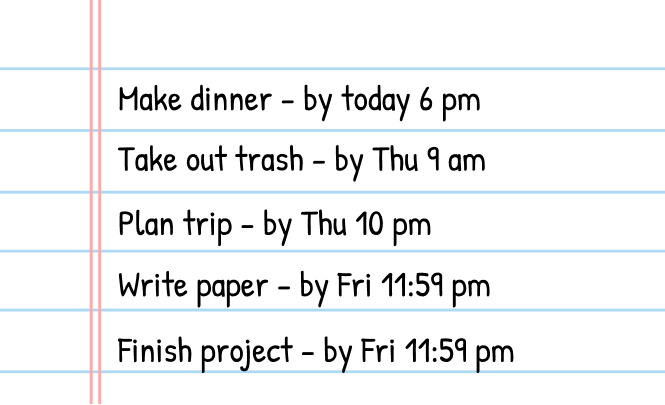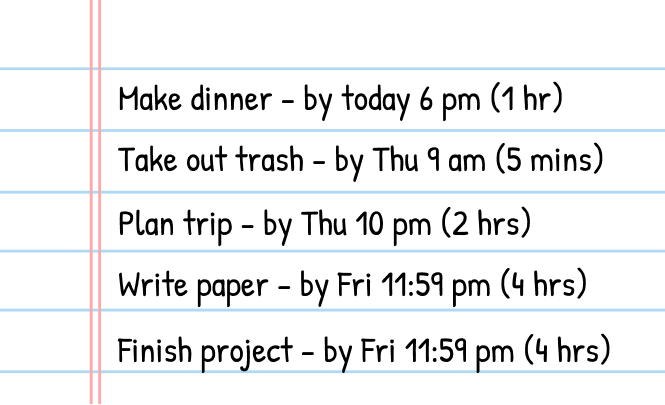Introduction to Time Blocking
Finding time for all your different responsibilities and making sure nothing falls through the cracks can sometimes be a serious challenge. That’s where time blocking comes in. It’s a simple but effective technique that helps you stay focused, reduce stress, and actually get things done.
But what exactly does it mean to time block? In this article, we’ll break down the basics of time blocking, why it works, and some common pitfalls to avoid.
What is a time block?
A time block is a specific chunk of time that you dedicate to one task or activity.
Instead of creating a to-do list and hoping for the best, you plan out exactly when you’ll do each task, and then focus on only that task during its time block. For example, you might set aside 9am – 10am for working on a project, then block out 30 minutes after that for answering emails.
The idea is to create a schedule where your day is divided into manageable blocks, with each one assigned to something important. You can make blocks as short or long as needed, and they can be flexible depending on your tasks.
If you’re looking for the easiest way to set up time blocks, use a smart calendar that automatically time blocks your to-do list into your schedule for you, like FlowSavvy.
Benefits of Time Blocking
Time blocking isn’t just about making a pretty calendar—it’s about being intentional with your time to accomplish more while reducing stress. Here’s why it works:
- Helps You Stay Focused: Time blocking lets you dedicate specific periods to a single task, which helps you cut out distractions. When you know you’ve set aside time for a task, you’re more likely to focus and stay in the zone, instead of jumping from one thing to another.
- Prevents Overwhelm and Stress: A never-ending to-do list can make you feel like you’re always behind. Time blocking gives structure to your day, making everything feel more manageable. Instead of stressing over how many things you have left to do, you can just focus on the task at hand, knowing everything else has its place and will get done.
- Avoid Procrastination: When you dedicate specific blocks of time to important tasks, you’re less likely to waste time or procrastinate. There’s something about having a time on the calendar that makes you more likely to follow through. The time is already blocked out for it; might as well do it!
- Encourages Better Work-Life Balance: It’s easy to let work spill into your personal time, especially if you don’t have clear boundaries. Time blocking helps you create those boundaries. By scheduling personal time—whether it’s for hobbies, exercise, or relaxing—you can ensure that you’re making time for yourself and the things you enjoy, rather than letting work take over your entire day.
- Reduces Decision Fatigue: Deciding what to work on next can drain your mental energy, especially if you’re constantly switching between tasks. With time blocking, that decision is made ahead of time. When you look at your schedule, you already know what you need to do and when. This reduces the mental load of constantly deciding what to tackle next, making your day run smoother.
Who Can Benefit from Time Blocking?
The beautiful thing about time blocking is it is so customizable to different workflows, so it can be used whether you’re at a desk, on your feet all day, have a fixed schedule, or a constantly changing schedule.
While anyone can benefit immensely from time blocking, here are some of the common use cases we’ve seen:
- Professionals – Plan when you’ll do important work so you can ensure you’ll meet all deadlines.
- Entrepreneurs – Set deadlines for yourself and plan time blocks to ensure you’re using your time efficiently.
- Students – Avoid last minute cramming by planning out study time and social activities.
- Busy parents – Ensure nothing falls through the cracks by assigning every task a time in the calendar.
How to Implement Time Blocking in Your Life
If you’re ready to take control of your schedule and stop feeling like you’re constantly playing catch up, time blocking might be the answer. Here’s how you can get started:
1. Choose where you’ll create your time blocks
You’ll need somewhere to put your time blocks. Here are some options:
- Physical daily/weekly planner
- Whiteboard
- Simple Calendar app
- For an easy place to start, check out our guide on time blocking Google Calendar.
- Apps specifically designed for time blocking
- While some of these might be more expensive than a basic calendar like Google Calendar, they’re designed specifically for time blocking.
2. Fill your calendar with fixed commitments first
Putting tasks in the calendar will just be wasted effort if we have to move them around later to put events in. So, put all your fixed commitments in your calendar first. Ex: Appointments, meetings, wakeup/winddown routines, etc.

3. List Your Tasks
First things first: Write down everything you need to get done. This can be work-related tasks, personal errands, or even something simple like making time for a walk. The goal here is to have a clear picture of what you need to accomplish so that nothing falls through the cracks.

4. Prioritize tasks
Not everything on your list will carry the same weight. Some tasks are more important, and some can wait. Prioritize your list by figuring out what absolutely needs to get done today and what can be pushed to later. This will help you make sure that your time blocks are focused on what really matters, not just what’s urgent.

5. Estimate durations
To prepare for putting these tasks in the calendar, we need to know how long the task will take. These don’t have to be perfect; just put a rough estimate of how long you think it will take. I recommend overestimating task durations to start (1.5x is a good rule of thumb), and then you can adjust accordingly as you get better at time blocking.

6. Assign Time Blocks for Each Task
Now that you have your tasks and priorities, it’s time to assign them a specific time slot. Start with today and block off time for your tasks in any free space.
Remember to include breaks and time for fun!

7. Follow your schedule
Sticking to your planned time blocks is often the hardest part of time blocking. While your calendar can’t complete the work for you, it can definitely help you stay on track.
Here are a few ways to make following your schedule easier:
- Keep your calendar within reach: Whatever time blocking tool you chose, make sure it’s always accessible so you can quickly check your time blocks, no matter where you are.
- Set reminders: If you’re using digital tools, enable notifications on your devices to get timely alerts when it’s time to start or prepare for a task. These reminders can keep you accountable and help you transition smoothly between activities.
- Try an accountability partner: Review your schedule with someone else and then tell them what you did at the end of the day or week. Having an accountability partner can help give an external push to stay on track.
8. Review and Adjust Regularly
At the end of each day or week, take a few minutes to look over how things went. Did you stick to your blocks? Were there tasks that always took longer than expected? Were there times when you felt rushed? Use these insights to tweak your schedule moving forward. The more you fine-tune your time blocks, the better they’ll work for you.
Common Challenges with Time Blocking and How to Overcome Them
Time blocking can be a game-changer for managing your day, but like any productivity method, it comes with its own set of challenges. The good news is that most of these obstacles have simple solutions. Let’s dive into some of the most common issues and how to handle them.
1. Falling Behind or Plans Changing
One of the biggest challenges with time blocking is when things don’t go according to plan. Maybe a meeting runs long, or you underestimate how much time a task will take. Suddenly, your perfectly blocked schedule is thrown off, and it’s easy to feel like giving up time blocking.
Solution: Use an automatic time blocking calendar like FlowSavvy. Unlike traditional calendars, FlowSavvy automatically adjusts your schedule when things shift or take longer than expected. It re-blocks your time in real-time, so even if you fall behind or your plans change, you can stay on track without having to manually reschedule everything. This flexibility can keep you from feeling defeated when the day doesn’t go as planned.
Automatic time blocking makes creating a calendar and sticking with time blocking over the long term much easier. Try automatic time blocking today with FlowSavvy’s smart calendar:
2. Difficulty Estimating Time
It’s not always easy to predict how long a task will take, especially if it’s something you haven’t done before. This can lead to your time blocks either being too short (causing stress when you can’t finish on time) or too long (leading to wasted time).
Solution: Start by estimating everything at 1.5x the time you think it will take. Overestimating and then finishing early is much better than underestimating and then feeling like you’re falling behind. You’ll start to get better at knowing how long each task will take, and then you can adjust accordingly.
3. Overloading Your Schedule
It’s easy to get excited about time blocking and start cramming every minute of your day with tasks. The problem? You end up with an unrealistic schedule that doesn’t allow for breaks or unexpected interruptions. This can lead to burnout or frustration when you can’t keep up with your own plan.
Solution: Build in buffer time. Give yourself more time than you think you’ll need for certain tasks (a good rule of thumb is 1.5x the time you think it’ll take), and schedule short breaks between blocks. This extra space will help you catch up if something takes longer than expected, and it also gives your brain a chance to rest.

4. Not being able to schedule everything
There are only 24 hours in a day. That might mean that not everything can fit into your schedule, which can lead to a sense of overwhelm. It can be tempting to throw out the entire schedule just to avoid the anxiety/overwhelm. However, good time blocking can actually reduce that feeling and make you feel relaxed, knowing that everything will get done.
Solution: Use the 80/20 rule: focus on the 20% of tasks that will deliver 80% of the results. If something isn’t urgent or important, consider whether it needs to be done at all. This will help you cut through the clutter and schedule time for the things that actually matter.
5. Getting Distracted
Even with a solid time-blocking plan in place, distractions can sneak in and throw you off track.
Solution: Be proactive about minimizing distractions during your blocks. Turn off notifications, and put your phone on Do Not Disturb. You can also use apps like Forest and Opal to help you stay in the zone and avoid distractions during deep work blocks. The key is to treat each block as a non-negotiable commitment.
Conclusion: Is Time Blocking Right for You?
At the end of the day, time blocking is just a tool—it’s not a magic fix for all your time management struggles, but it can be a game-changer if used right. If you often feel like you’re bouncing from task to task, constantly running out of time, or struggling to stay focused, time blocking might be worth trying.
If you want an easy way to implement and stick with time blocking, give FlowSavvy a try. FlowSavvy automatically schedules your to-do list into your calendar and adjusts instantly as plans change, making it easier to stick with time blocking.

